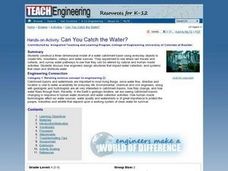Curated OER
Water Quality Survey: Monitoring the Sustainability of Pigeon Creek
High schoolers research the History of Pigeon Creek (or any watershed in your area). In this environmental science lesson, students conduct field tests such as pH and nitrates. They collect data and compare what they collected with other...
Curated OER
Water: An Endangered Resource
Young scholars explore the concept of watersheds. They investigate how the reclamation of abandoned coal mines in Pennsylvania improves water quality. In addition, they diagram the components and assess the value of a passive treatment...
Curated OER
Wet 'n Wild Watershed
Students engage in a discussion on watershed management. In this ecology lesson, students consider the role of forests in water quality. Students incorporate lecture material into a class room discussion and questions on water shed...
Curated OER
Storage, Use, Pollution,& Clean Up of Water
Students synthesize water resource educational posters into class presentations based on the poster's theme. Working in groups, they make presentations on wastewater, water uses, watersheds, groundwater, wetlands,water quality, and...
National Wildlife Federation
Go with the Flow
The quality of a watershed has a direct impact on the community it services. Learners study their own watershed using a topographical map. They recreate the watershed components using colored pencils to track the upstream and downstream...
Curated OER
The Politics of Water
Students investigate the Governor's Kansas Water Initiative. Students study rivers, cities and reservoirs and how their location effects the importance of their water quality issues.
Curated OER
Field Work
Young scholars realize that everyone lives in a watershed and that water is a fundamental life sustaining resource, they investigate ways to look at surface streams for quantity and quality of this vital resources. Students construct a...
Curated OER
Water Is Cool!
Young scholars explore the importance of water. In this water lesson, students view a table to determine the amount of water found in the oceans, lakes, atmosphere, and streams. Young scholars discuss ways to be a good steward of water.
Curated OER
Introduction to the Biotic Water Quality of a Stream
In this lesson plan, middle schoolers properly use a taxonomic key to identify benthic organisms. Students go onto collect aquatic macroinvertabrate and then ennumerate all organisms colelcted. The culminating activity is the Project...
Curated OER
Wetland in a Pan
Students examine wetlands and what the effects of destroying them will do. In this wetland lesson students relate the importance of wetland functions to their own needs.
Curated OER
Leaf Pack Study
Students conduct an experiment using leaf packs. In this leaf lesson plan students complete an activity in groups and complete a handout.
Curated OER
Pollution is Not a Solution
Students explore the environment by completing science worksheets in class. In this water conservation lesson plan, students identify ways water is used in our society and how we abuse the privilege. Students discuss methods to reduce...
Curated OER
Salt Marsh in a Pan
Students create a model of a salt marsh to discover the impact of pollution and human activities on water-based habitats including bays and the ocean. They recognize the relationship between natural and developed areas. Students impact...
Curated OER
Graphing Aquatic Insects
Students identify aquatic insects. In this organism lesson, students locate aquatic insects near a local waterway and collect them. Students graph the amount of insects that they collected.
Curated OER
Salinity and Brackish Water Systems
Students are able to tell the difference between brackish and salt water. They also are able to distinguish water qualities specific to each type of water. Students answer various questions about all types of water.
Curated OER
Science Excursion: Cover Mapping Land
Students study remotely sensed images and topographic maps to classify land cover types in their watershed area. They take samples in the watershed area to interpret the images.
Curated OER
Marine & Aquatic Habitats -- Journey of a Drop of Water Through a Watershed
Students discuss pollution and the steps in the hydrologic cycle. They follow a drop of water through a watershed simulation. They discover the components of a water cleaning system as well.
Curated OER
Don't Water....Shed A Tear#145
Students examine the definition and attributes of tributaries and watersheds. They design a landscape which includes a mountain, a river, a lake and other appropriate items. They observe as the teacher pours water through the landscape...
Curated OER
Water Taste Test
Young scholars brainstorm the different characteristics of potable water. In this general science lesson plan, students test several water samples and hypothesize which samples and brands they are. They discuss where drinking water came...
Curated OER
Can You Catch the Water?
Students work together to construct a model of a water catchment basin. They survey water patterns and complete experiments to see where rain travels and collects. They discover how engineers design structures that help with drainage.
Curated OER
What's in the Water?
Middle schoolers examine water data for up to a month and perform tests on the samples.
Curated OER
Fish Kills!
Students investigate a fish kill occurrence, the Lake Iluka simulation. They examine what would happen if a fish kill happened today in their watershed area? what type of problems it might cause? They also discuss in groups any specific...
Curated OER
Turning the Tide on Trash: Marine Debris Curriculum
Seven pages of fascinating reading on marine debris preface the activities in this lesson plan. Four different activities are employed to simulate how the debris is distributed in the ocean and along beaches. Early ecology learners...
Curated OER
Land Use and Nitrogen
Students consider the effects of development on water quality. They test nitrogen levels in waters before and after development, investigate wastewater treatment options and research best management practices to reduce nitrogen loads.

























